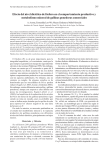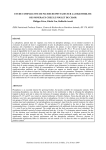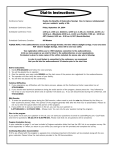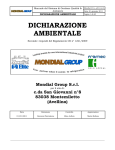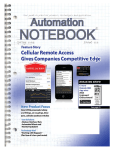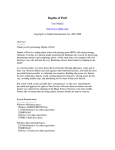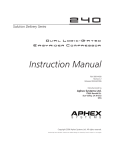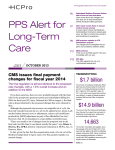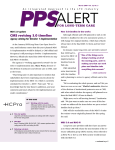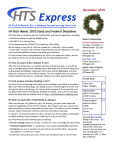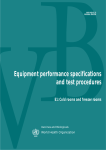Download The MDS Decoder: ADLs
Transcript
The MDS Decoder ADLs The MDS Decoder: ADLs is published by HCPro, Inc. Copyright 2003 HCPro, Inc. All rights reserved. Printed in the United States of America. 5 4 3 2 1 ISBN 1-57839-257-8 No part of this publication may be reproduced, in any form or by any means, without prior written consent of HCPro or the Copyright Clearance Center (978/750-8400). Please notify us immediately if you have received an unauthorized copy. HCPro provides information resources for the health care industry. HCPro is not affiliated in any way with the Joint Commission on Accreditation of Healthcare Organizations, which owns the JCAHO trademark. Joanne Finnegan, Managing Editor Kelly Wallask, Group Publisher Jean St. Pierre, Creative Director Mike Mirabello, Senior Graphic Artist Tom Philbrook, Cover Designer Paul Bilodeau, Photographer Suzanne Perney, Publisher Advice given is general. Readers should consult professional counsel for specific legal, ethical, or clinical questions. Arrangements can be made for quantity discounts. For more information, contact: HCPro P.O. Box 1168 Marblehead, MA 01945 Telephone: 800/650-6787 or 781/639-1872 Fax: 781/639-2982 E-mail: [email protected] Visit HCPro at its World Wide Web sites: www.hcmarketplace.com, www.hcpro.com, and www.snfinfo.com. 4/2003 17010 The MDS Decoder: ADLs Contents Acknowlegements . . . . . . . . . . . . . . . . . . . . . . . . . . . .iv The ADLs and the MDS . . . . . . . . . . . . . . . . . . . . . . . . . . . . 1 What are the ADLs? . . . . . . . . . . . . . . . . . . . . . . . . . . . . . . .1 A difficult job . . . . . . . . . . . . . . . . . . . . . . . . . . . . . . . . . . . .1 Understand the importance of the MDS . . . . . . . . . . . . . . 2 Definitions of the ADLs . . . . . . . . . . . . . . . . . . . . . . . . . . . . 4 Correct coding is crucial . . . . . . . . . . . . . . . . . . . . . . . . . 6 Consider some examples . . . . . . . . . . . . . . . . . . . . . . . . 8 Measuring self-performance . . . . . . . . . . . . . . . . . . . . . . . . . 8 Measuring support provided . . . . . . . . . . . . . . . . . . . . . . . . 14 Now test your knowledge . . . . . . . . . . . . . . . . . . . . . . . . 17 How to improve documentation . . . . . . . . . . . . . . . . . . . 19 Pop quiz . . . . . . . . . . . . . . . . . . . . . . . . . . . . . . . . . . . . . . 23 Answer key . . . . . . . . . . . . . . . . . . . . . . . . . . . . . . . . . . . . 25 Certificate of Completion . . . . . . . . . . . . . . . . . . . . . . . . . . 26 ©2003 HCPro, Inc. Unauthorized duplication is prohibited. iii The MDS Decoder: ADLs Acknowledgements HCPro wishes to thank Julia Hopp, MS, RN, CNAA, BC— vice president of patient accounting for San Antonio–based Paramount Healthcare Company—for her help in reviewing this handbook. We also thank Administrator Paul Mahoney, CNAs Carolynn Stanley and Chantal Basile, and resident Teresa Wyatt of the Rosewood Nursing and Rehabilitation Center in West Peabody, MA, for their cooperation in taking the photographs for this handbook. We also thank owner Richard Bane, president of the Bane Skilled Care Residences. iv ©2003 HCPro, Inc. Unauthorized duplication is prohibited. The MDS Decoder: ADLs The ADLs and the MDS What are the ADLs? Activities of daily living (ADLs) are the simple activities of life that most of us take for granted—getting dressed, eating, moving from place to place. But for many nursing home residents, performing these tasks is a challenge. As a caregiver, you know that the ability to perform these simple activities can vary greatly from one resident to the next. It is the responsibility of a nursing home’s staff members— especially nurses and certified nursing assistants (CNAs) like you—to determine each resident’s ability to perform these ADLs. Staff must monitor the condition and abilities of all residents around the clock, 365 days a year, not only a few times a week or month. A difficult job Unfortunately, assessing the ability of residents to perform these basic daily tasks is not an exact science. Have you ever been confused as you’ve tried to code the ADLs on the Minimum Data Set (MDS)? If you have, you should know that you are not alone. The ©2003 HCPro, Inc. Unauthorized duplication is prohibited. 1 The MDS Decoder: ADLs coding of the ADLs is one of the most difficult and confusing tasks for nursing staff. Study after study has reached the same conclusion. For instance, in a recent government report, 40% of the MDS coordinators surveyed identified Section G of the MDS— physical functioning and structural problems—which deals with the ADLs, as the most difficult to complete. And that’s the reason for this handbook: to help you improve accuracy on the coding of this crucial section of the MDS. Assessment of the ADLs is crucial to both your residents’ well-being and the financial health of your nursing home. Understand the importance of the MDS Accuracy on the MDS depends on your ability to interpret definitions and standards you may not be completely clear about. This handbook is here to clarify many of the issues and terms involved in documenting and coding your residents’ ADLs. The MDS just may be the most important piece of paper in your nursing home. Think of the MDS form as a checklist to record the conditions a resident has—or doesn’t have. Staff members complete the MDS at specified intervals. 2 ©2003 HCPro, Inc. Unauthorized duplication is prohibited. The MDS Decoder: ADLs The MDS is an important piece of paper for all of the following reasons: • It helps establish a plan of care for each resident. Based on the problems you document on the MDS, staff will develop a care plan to address those needs. For instance, Mrs. Jones can no longer dress herself without help and needs cuing to brush her teeth and comb her hair. Her care plan will indicate that she needs the help of her CNA each morning to get her ready to start the day. • The form determines how much Medicare reimbursement your nursing home receives. Without sufficient Medicare funds, both the facility and its residents lose out. • The form affects the quality of care for residents. An accurate assessment of a resident’s conditions means he or she will receive the level of care needed. For instance, if your assessment indicates that a resident is doing better than he or she actually is, the resident may not receive the level of care and attention he or she really needs. • The Centers for Medicare & Medicaid Services (CMS) uses the data to develop your nursing home’s quality indicators (QIs), which identify areas of potential concern for surveyors during facility surveys or inspections. ©2003 HCPro, Inc. Unauthorized duplication is prohibited. 3 The MDS Decoder: ADLs • CMS uses the MDS data to develop your facility’s quality measures (QMs), which are data that it posts on the Internet to help consumers compare the quality of different nursing homes. For these many reasons, it is critical that you accurately complete every section of the MDS. Definitions of the ADLs One section of the MDS that is particularly critical is Section G. The ADLs are found in this section, which is entitled “Physical functioning and structural problems.” As you now know, Section G is one of the most difficult and confusing for staff members to code. Review the following MDS definitions of each ADL, which nurses and CNAs must observe and code: 1. Bed mobility (item G1a)—assesses the resident’s ability to move around in bed, move to and from a lying position, turn from side to side, and position him- or herself in bed. 2. Transfer (item G1b)—includes transfers to and from the bed, stationary chair, wheelchair, and to a standing position. Do not include transfers to and 4 ©2003 HCPro, Inc. Unauthorized duplication is prohibited. The MDS Decoder: ADLs from the bath or toilet in this item of the MDS. 3. Walk in room (item G1c)—assesses how the resident walks between locations in his or her room. 4. Walk in corridor (item G1d)—assesses how the resident walks in the corridor on the unit. 5. Locomotion on unit (item G1e)—assesses how the resident moves between locations in his or her room and adjacent corridor on the same floor. If the resident is in a wheelchair, assess self-sufficiency once in the chair. 6. Locomotion off unit (item G1f)—assesses how the resident moves to and returns from off-unit locations such as dining, activity, or treatment areas. If the facility has only one floor, assess how the resident moves to and from distant areas on the floor. If the resident is in a wheelchair, assess self-sufficiency once in the chair. 7. Dressing (item G1g)—assesses how the resident puts on, fastens, and takes off all items of clothing, including donning/removing a prosthesis. 8. Eating (item G1h)—assesses how the resident eats or drinks by all means including oral, tube feedings, or total parenteral nutrition. 9. Toilet use (item G1i)—considers how the resident ©2003 HCPro, Inc. Unauthorized duplication is prohibited. 5 The MDS Decoder: ADLs uses the toilet, commode, bedpan, or urinal. This item also looks at how the resident transfers to and from the toilet or commode, cleanses him- or herself, changes pads, manages a catheter or ostomy, and adjusts clothing following toileting. 10. Personal hygiene (item G1j)—assesses how the resident maintains personal hygiene, including combing or brushing hair, shaving, applying makeup, and washing or drying face, hands, and perineum. Do not include taking of baths and showers in this item of the MDS. Correct coding is crucial It is important that you correctly code each ADL so your facility will receive the reimbursement it deserves and residents receive the care they need. Incorrect coding of the ADLs, or the absence of sufficient documentation to support the codes, can lead to significant reimbursement losses for your nursing home—even if it involves only one resident. An incorrect code can affect reimbursement by as much as $50 a day. All of the ADLs are coded in the following two categories: 1 6 Self-performance—a measure of what the resident actually does. It is not an indication of what the resident may be capable of. ©2003 HCPro, Inc. Unauthorized duplication is prohibited. The MDS Decoder: ADLs 2 Support provided—a measure of how much the staff do to assist the resident with each activity. Keep in mind that coding is based on your own and other staff members’ observation and assessment of the activity during the prior seven days. A common error that leads to inaccurate scoring occurs when you or others code Section G according to what you or they perceive as the long-term status of a resident. Remember that residents’ conditions can change dramatically during a seven-day period. If residents have a sudden decline that affects their ability to feed themselves, the consequences can be serious. That’s why it is critical that the code accurately represents the resident’s performance over the prior seven days—and the prior seven days only. Four of the ADLs are referred to as “late-loss” ADLs, or those that residents tend to be able to perform the longest during their lives. These are the most basic activities and are usually the last to disappear. Their decline could indicate that a resident’s health is failing. Those four ADLs are as follows: • Bed mobility • Transfer • Eating • Toilet use ©2003 HCPro, Inc. Unauthorized duplication is prohibited. 7 The MDS Decoder: ADLs Consider some examples Still confused? To help you understand how to code these ADLs, here are some examples using “transfer” to demonstrate the various self-performance codes. You can use the same lesson to code all of the ADLs in Section G. First, let’s review what is meant by the “transfer” ADL. It includes all the resident’s movements between the bed, chair, wheelchair, and the standing position. Transfer does not include movement to and from the toilet or bath. Measuring self-performance Remember that the code you give must be based on what the resident actually does, not what you feel or know the resident is capable of. You have a choice of the six different codes detailed in the following pages. 8 ©2003 HCPro, Inc. Unauthorized duplication is prohibited. The MDS Decoder: ADLs The resident gets out of bed without assistance and gets into her chair. 0 = Independent. The resident can perform this ADL on his or her own, without help from staff or supervision. Code the activity as independent even if the resident has had staff help or supervision—as long as it wasn’t more than once or twice during the seven-day assessment period. Example: In this case, the resident is capable of her own transfers, such as moving from the bed to the chair, and does not need staff help or supervision. But when assigning a code, don’t forget to consider the time frame involved as described in the definition. ©2003 HCPro, Inc. Unauthorized duplication is prohibited. 9 The MDS Decoder: ADLs A staff member supervises the resident as she moves from her bed to the chair, reminding her to lower her body slowly. 1 = Supervision. Use this code if the resident needs supervision, encouragement, or cuing three or more times during the seven-day assessment period. Use this code even if the resident needed physical assistance, as long as it was not provided more than twice during the period. Example: In this case, a staff member encourages the resident, who is sitting up in bed by herself. The staff member walks by the resident’s side but doesn’t need to hold her arm as she moves over to the chair. 10 ©2003 HCPro, Inc. Unauthorized duplication is prohibited. The MDS Decoder: ADLs 2 = Limited assistance. Use this code when the resident is very involved in the activity, and has received physical help only through the guided maneuvering of limbs or other non-weight-bearing assistance on three or more occasions. This code also applies to The resident gets out of bed and moves cases in which a resito the chair, as the staff member puts dent needs this limited her hand on the resident’s shoulder to guide her. assistance three or more times and additional increased assistance was needed no more than two times. Example: In this case, the resident is very involved in getting out of bed and receives physical help only as the staff member puts an arm on her shoulder to steady her as she sits down. ©2003 HCPro, Inc. Unauthorized duplication is prohibited. 11 The MDS Decoder: ADLs 3 = Extensive assistance. Use this code when the resident has performed part of the activity, but one or both of the following types of assistance occurred: • The resident needed weight-bearing support three or more times during the activity A staff member lifts the resident around her waist to help her sit up straight in the chair. • The staff performed the activity without any help from the resident, three or more times during some—but not all— of the last seven days Remember that weight-bearing assistance is defined as bearing the weight of the resident. In other words, it means lifting a part of the resident’s weight. Example: In this case the resident is able to move from the bed to the chair, with the staff member lifting part of her body to help her sit up straight in the chair. 12 ©2003 HCPro, Inc. Unauthorized duplication is prohibited. The MDS Decoder: ADLs 4 = Total dependence. The resident needs staff to fully perform the activity for him or her during the entire seven-day period and did not participate in any aspects of the ADL. Example: Two staff members help physically lift and transfer the resident to a reclining chair. The resident needed staff to fully perform any transfer throughout the sevenday period. The resident did not participate at all during any transfers in the prior seven days. Two staff members help the resident up from the bed so they can move her from the bed into a chair. 8 = The activity was not performed by the resident or staff during the entire seven-day period. Code 8 is used only if the activity—in this case, a transfer— did not occur at all during the prior seven days, by either the resident or staff. ©2003 HCPro, Inc. Unauthorized duplication is prohibited. 13 The MDS Decoder: ADLs Measuring support provided This is a measure of how you or other staff members assist the residents in performing each activity. Once again, we will use the example of “transfer” to show you how to code in the support provided category. You have a choice of the following five different codes: 0 = No setup help or physical help from staff. The resident can perform the activity entirely on his or her own. Setup help refers to staff providing the resident with articles, devices, or preparation necessary to help the resident perform an activity with as little physical help as possible. A code of 0 means residents are able to perform the activity entirely on their own, such as moving from the bed to a chair. 1 = Setup help only. The resident is provided with materials or devices necessary to perform the ADL independently. The resident moves from the bed to a standing position, as her nurse assistant makes sure her walker is in place. 14 ©2003 HCPro, Inc. Unauthorized duplication is prohibited. The MDS Decoder: ADLs A 1, or setup help, only means staff simply provide the resident with materials or devices, such as a cane or walker, to perform the transfer. 2 = One person physical assist. One staff member provides the resident with physical assistance. 2 is defined as one staff person providing the resident with physical assistance, again in the prior seven days. A staff member holds the resident’s arm as she leads her to sit down on the bed. ©2003 HCPro, Inc. Unauthorized duplication is prohibited. 15 The MDS Decoder: ADLs 3 = Two or more persons physical assist. Two or more staff members provide the resident with physical assistance. 3 means two or more staff provided the resident with physical assistance in order to perform the transfer. Two staff members help the resident up from the chair, so they can move her from the chair into a bed. 8 = The activity was not performed at all in the prior seven days, by either the resident or staff. 8 means the activity, a transfer, did not occur at all in the prior seven days. Here’s a handy tip: If 8 is coded under the support provided category, then enter the same 8 code for that ADL under the self-performance category. In documenting the amount of ADL support provided to the resident, the code you enter should reflect the highest level of assistance that you provided during the entire seven days, even if it only occurred once. 16 ©2003 HCPro, Inc. Unauthorized duplication is prohibited. The MDS Decoder: ADLs Now test your knowledge Keep in mind that all of the other ADLs are coded the same way using the same basic definitions. However, the differences in ADL performance codes can be very subtle—and confusing—at times. Q: So for instance, how would you code the eating category when a resident is sitting up in bed and enjoying a meal by herself? A: A: Code “Independent” or 0 under the self-performance category to indicate that the resident needs no assistance eating or drinking. Q: How would you code a scenario in which a resident in bed is turned from one side to another by staff without the resident’s help? Code the bed mobility ADL as 4, or “total dependence,” under self-performance because staff turn the resident from side-to-side with no assistance from the resident. A: A: Q: How would you code a case in which one staff member helps a resident by lowering him onto the toilet seat? A: A: Code this as a “one-person physical assist,” or a 2, under the support provided category for the toilet- ©2003 HCPro, Inc. Unauthorized duplication is prohibited. 17 The MDS Decoder: ADLs use ADL. The nurse assists the resident in moving on and off the toilet. Q: How would you code a case in which a resident needs encouragement to stand up from a chair three days out of the last seven? Code this as a 1 under the self-performance category for transfer indicting she needed supervision, even if she stood up without any trouble the other four days of the assessment period. A: A: Tip: Always look at what was, not what could have been. Item G1 is not the place to assess a resident’s potential abilities. Rather, it is meant to be a snapshot of what the resident actually did during the assessment period. Item G8 on the MDS assesses a resident’s rehabilitation potential. For example, you believe that a male resident is depressed and has lost interest in dressing himself, even though he is perfectly capable of doing so. He was able to put on his shirt without any help during the majority of the assessment period, but he asked you to guide his arm into the armhole three times. Despite your suspicions that he was able to dress on his own, you would have to code a 2 for limited assistance in dressing and a 2 for one-person physical assist in dressing. Likewise, do not code the ADLs according to what the resident’s care plan says he or she should be capable of. 18 ©2003 HCPro, Inc. Unauthorized duplication is prohibited. The MDS Decoder: ADLs How to improve documentation The following are six steps you can take to make sure coding of the ADLs is accurate. The more accurate your coding, the better off your residents and facility will be. 1. It’s important that each staff member gathers information accurately. Your facility’s MDS coordinator will need to collect information from the whole team, throughout all shifts—not only a few staff members—to get a full picture of each resident’s ability. As you know, a resident’s condition or ability to perform ADLs may fluctuate throughout the seven-day assessment period or even at various times during the day. The code needs to reflect the assessment by the whole team on all shifts. The documentation you provide helps contribute to that team effort. Always record accurate information. Don’t simply copy what the previous shift of CNAs documented. 2. Be sure you properly document your work. Documentation is an important part of a nurse’s or CNA’s responsibilities. Make sure you understand how documentation affects reimbursement and resident care. Improve your documentation skills with the following three steps: • Take advantage of any ongoing education. Use this handbook to review the definitions used in coding, ©2003 HCPro, Inc. Unauthorized duplication is prohibited. 19 The MDS Decoder: ADLs such as the difference between weight-bearing and non-weight-bearing assistance. Tip: Although weight-bearing assistance may seem like a difficult concept, try thinking of it this way: You are probably providing weight-bearing assistance if you have to change the position of your feet or bend your knees to assist the resident. Of course, don’t forget that supporting a frail person’s arm—no matter how light he or she is—is also considered weight-bearing assistance. • Be sure to use the assessment tools your facility provides, such as checklists that can help you document what happens each day. A checklist can help you keep a better record of how many times a resident was helped with toilet use during the week and the level of assistance required each time. Record the information right away. Otherwise, you have to rely on your memory, which may not be accurate because you care for so many people during your shift. If your facility does not have an easy-to-use form, check out some sample forms from other nursing homes posted at www.snfinfo.com by clicking on “PPS Resource Center” and then “MDS.” • Give credit where it’s due. Too often nurses and nursing assistants don’t give themselves credit for the support they provide residents. You play an 20 ©2003 HCPro, Inc. Unauthorized duplication is prohibited. The MDS Decoder: ADLs important role in making sure residents receive the care they deserve and the facility receives proper reimbursement. 3. Complete self-performance coding separately from support provided coding to avoid confusion that can result when jumping back and forth between categories. First enter the self-performance codes for all the ADLs, then go back and enter the support provided codes for the same ADLs. 4. Take time to find the answers. When you’re not sure how to spell a word, you look it up in the dictionary. The same goes for coding ADLs. Refer back to this handbook for examples and definitions of the codes. If you’re still not sure how to code a situation, turn to the MDS coding “bible”—the Revised Long-Term Care Resident Assessment Instrument Version 2.0 User’s Manual—for clarification. Or check with a supervisor. 5. Keep in mind that nurses and therapists often don’t “speak the same language,” and view the same situation from different perspectives. This can show up in the way both of you document a resident’s condition. A therapist may see a resident at his or her best, as the person works with the therapist to improve. The therapist might code the resident as fairly independent since the person may perform at a higher level during therapy sessions. Nursing staff may see the resident the rest of ©2003 HCPro, Inc. Unauthorized duplication is prohibited. 21 The MDS Decoder: ADLs the time and have a different view. For instance, when a resident is tired at the end of the day, he or she may require a lot more assistance on those activities. Nurses and therapists need to use the same definitions of each activity and type of support in order to provide consistency in documenting a resident’s condition. Inconsistent documentation often attracts the attention of state surveyors. 6. Be concise. Use brief and specific descriptions and you’ll save time and contribute to more accurate coding. Your facility does not get reimbursed for the time it takes to observe, document, and code a resident’s ADL abilities. 22 ©2003 HCPro, Inc. Unauthorized duplication is prohibited. The MDS Decoder: ADLs Pop quiz The following questions relate to the activities of daily living (ADLs) handbook you have just read. Please respond to the questions to the best of your ability. 1. There is only one primary purpose of the Minimum Data Set (MDS), which is to determine how much Medicare reimbursement a facility receives. ❑ True ❑ False 2. All of the ADLs are coded under the following two categories: self-performance and support provided. ❑ True ❑ False 3. Self-performance is an indication of what a resident may be capable of rather than a measure of what he or she actually does in performing a task. ❑ True ❑ False 4. It’s critical that the code entered on the MDS represents the resident’s performance over the prior seven days—and the prior seven days only. ❑ True ❑ False 5. Identify the four late-loss ADLs. ©2003 HCPro, Inc. Unauthorized duplication is prohibited. 23 The MDS Decoder: ADLs 6. A resident is sitting up in bed and enjoying a meal on her own. In the eating category, how would you score this resident under the self-performance category? 7. You assist a resident by guiding his arm into the armhole of his shirt. Under the support provided category for the dressing ADL, you should code this as “2” for a one-person physical assist. ❑ True ❑ False 8. It is best to go back and forth between categories as you code each ADL, entering the self-performance codes and support provided codes for the same ADL. ❑ True ❑ False Name Title Date 24 ©2003 HCPro, Inc. Unauthorized duplication is prohibited. The MDS Decoder: ADLs Answer key 1. False. The MDS also helps a nursing home establish a plan of care for its residents and can have a direct impact on the quality of care they receive. The data is also used to develop a facility’s quality indicators and quality measures. [See p. 3 for more information.] 2. True. [See p. 6.] 3. False. Remember that the code you give must be based on what the resident actually does, not what you feel or know the resident is capable of. [See p. 7.] 4. True. [See p. 7.] 5. Bed mobility, transfer, eating, and toilet use. [See p. 7.] 6. Score this resident as “independent” or as a “0” since the resident needs no assistance eating or drinking. [See p. 17.] 7. True. One person assists the resident in dressing. [See p. 15.] 8. False. Remember to complete self-performance coding separately from support provided coding to avoid confusion that can result from jumping back and forth. [See p. 21.] ©2003 HCPro, Inc. Unauthorized duplication is prohibited. 25 OF COMPLETION Suzanne Perney Vice President/Publisher The MDS Decoder: ADLs has read and successfully passed the final exam of This is to certify that CERTIFICATE Resources Visit our Web site at www.snfinfo.com for news, information, and helpful advice about long-term care. Sign up for our free e-zine SNFinfo Connection at www.snfinfo.com, to receive news and other information about the long-term care industry. Need more copies? That’s easy Call customer service at 800/650-6787 for more information or to order additional copies. For bulk ordering information, see below. Call: 800/650-6787 E-mail: [email protected] Internet: www.hcmarketplace.com Mail to: HCPro, Inc., P.O. Box 1168, Marblehead, MA 01945 Fax: 800/639-8511 For special pricing on bulk orders, please call Dave Miller toll-free at 888/209-6554. The MDS Decoder: ADLs The MDS Decoder: ADLs If you’ve ever been confused as you’ve tried to code the activities of daily living (ADLs) on the Minimum Data Set (MDS), you’re not alone. The truth of the matter is, coding of the ADLs—such as getting dressed, eating, and moving from place to place—is one of the most difficult and confusing tasks for nursing staff. Study after study has reached that conclusion. In a recent government report, 40% of MDS coordinators surveyed identified Section G of the MDS, which includes the ADLs, as the most difficult area to complete. That’s why we created The MDS Decoder: ADLs—to explain simply what the ADLs are and to help you improve accuracy on the coding of this crucial section of the MDS. This user-friendly handbook will answer all your questions, including: • What are the ADLs? • Why are they so important to my nursing home? • What are the six ways I can improve documentation of the ADLs? In addition, The MDS Decoder: ADLs includes examples and photographs to show you exactly how to code all kinds of scenarios. And you’ll want to keep the handbook as a quick reference for when questions arise. Take the confusion out of the MDS and the ADLs once and for all. It’s crucial to both your residents’ well-being and the financial health of your nursing home. Brought to you by HCProfessor™ HCProfessor is the online learning division of HCPro. P.O. Box 1168 Marblehead, MA 01945 ©2003 HCPro, Inc. Unauthorized duplication is prohibited. www.hcmarketplace.com 28 MDSADL

































